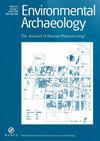炭炉作为环境档案:意大利波吉奥迪蒙蒂耶里的跨学科研究
IF 1.1
3区 地球科学
0 ARCHAEOLOGY
引用次数: 0
摘要
摘要本文介绍了在意大利中部的Poggio di Montieri进行的木炭炉遗迹的跨学科研究,该山丘在中世纪被大量开采用于提取含银矿石,然后直到19世纪以牧场为基础的多种土地利用系统进行管理。结合人类学、树木人类学和化学分析的土壤学和考古调查,以及历史文献和地图的信息,本研究概述了过去几个世纪发生在该地区的环境动态。虽然矿石加工无疑需要大量的木炭作为燃料,但没有中世纪的木炭炉遗迹的证据被发现,而从17世纪开始,至少有两个木炭生产阶段是独立的。尽管在18 - 19世纪的最后阶段,木炭产量有所增加,但没有记录显示Poggio di Montieri的森林资源被过度开采。没有这种预期的过度开发可能是由于使用了修剪和切碎的木材,这使得森林资源得以可持续管理,并且是前几个世纪多种土地利用制度的遗产。关键词:土壤学、树木学、人类学、森林、土壤历史生态学、木炭窑学分析披露声明作者未报告潜在的利益冲突。作者GM获得了由欧盟委员会和列日大学共同创立的居里夫人共同基金博士后奖学金(参考编号:600405)。作者VP获得热那亚大学博士学位,并在加泰罗尼亚古典考古研究所获得Juan de la Cierva - formion (FJC2019-040406-I)博士后奖学金。关于贡献者的说明。PesciniV。佩西尼是一名环境考古学家,专攻人类学和考古植物学。她的研究重点是农林牧实践及其对环境的影响。她分别在意大利锡耶纳大学获得中世纪考古学学士学位(2010年)和考古植物学硕士学位(2013年)。2019年,她完成了历史地理学博士学位,随后在意大利热那亚大学获得博士后职位。2020年,她被塔拉戈纳加泰罗尼亚古典学院(ICAC)授予Juan de la Cierva - formation奖学金(FJC2019-040406-I),并于2022年获得Ramon y Cajal junior奖学金(RYC2021-034621-I)。在她的职业生涯中,她曾与考古学家、博物学家、历史学家和地理学家合作过跨学科的研究项目。CertiniG。Certini是意大利佛罗伦萨大学的教育学正教授。他目前的研究兴趣是土壤的发生和退化、土壤碳固存、火灾对土壤性质的影响、土地占用和人类世。MastrolonardoG。马斯特罗罗纳多是研究土壤有机组分和土地退化的土壤科学家专家。他的兴趣之一是研究受野火影响的土壤的化学和物理特性以及碳化有机物质的积累。2013年,他在佛罗伦萨大学和巴黎大学获得双博士学位。2016年,他获得了由比利时里昂热大学共同资助的居里夫人博士后奖学金,自2021年以来,他一直是佛罗伦萨大学农业、食品、环境和林业科学与技术系(DAGRI)的研究员。本文章由计算机程序翻译,如有差异,请以英文原文为准。
Charcoal Hearth Remains as Environmental Archives: An Interdisciplinary Study at Poggio di Montieri, Italy
ABSTRACTThis contribution presents interdisciplinary research on charcoal hearth remains carried out at Poggio di Montieri, Central Italy, a hill heavily exploited in the Middle Ages for the extraction of silver-bearing ore, and then managed until the nineteenth century with a multiple land use system based on pasture. Linking together pedological and archaeological surveys with anthracological, dendro-anthracological and chemical analyses, as well as with information from historical texts and maps, this research outlines the environmental dynamics that occurred in this area in the last few centuries. Although ore processing undoubtedly required large quantities of charcoal as fuel, no evidence of charcoal hearth remains from the Middle Ages have been found, while at least two charcoal production phases, starting from the seventeenth century, were individuated. Despite an increase in charcoal production at the end of the last phase, in the eighteenth–nineteenth centuries, no over-exploitation of the forest resources at Poggio di Montieri was documented. The lack of such an expected over-exploitation could be due to the use of wood from pruning and shredding, which allowed the sustainable management of the forest resource and was the legacy of the multiple land use systems of previous centuries.KEYWORDS: pedologydendro-anthracologyforest soilhistorical ecologycharcoal kilnstopographic analysis Disclosure StatementNo potential conflict of interest was reported by the author(s).Additional informationFundingThe author GM has benefited a Marie-Curie COFUND postdoctoral fellowship, co-founded by the European Commission and the University of Liege (ref. number: 600405). The author VP has benefited a PhD grant by the University of Genoa and a Juan de la Cierva – formacion (FJC2019-040406-I) postdoctoral fellowship at the Catalan Institute of Classical Archaeology.Notes on contributorsV. PesciniV. Pescini is an Environmental Archaeologist, specialising in anthracology and archaeobotany. Her research focuses on the study of agro-sylvo-pastoral practices and their environmental effects through time. She received her Bachelor and Master’s degrees in Medieval Archaeology (2010) and Archaeobotany (2013) respectively at the University of Siena (Italy). In 2019 she completed her PhD in Historical Geography which was followed by a post-doctoral position at the University of Genoa (Italy). In 2020 she was awarded a Juan de la Cierva – formation (FJC2019-040406-I) scholarship at the Catalan Institute of Classical (ICAC) of Tarragona and in 2022 she obtained a Ramon y Cajal junior (RYC2021-034621-I). Throughout her career she has collaborated in interdisciplinary research projects with archaeologists, naturalists, historians and geographers.G. CertiniG. Certini is Full Professor of Pedology at the University of Florence, Italy. His current research interests are soil genesis and degradation, soil carbon sequestration, fire effects on soil properties, land take, and the Anthropocene.G. MastrolonardoG. Mastrolonardo is a soil scientist expert on the study of the organic fraction of soil and land degradation. Among his interests is the study of the chemical and physical properties of soil as affected by wildfires and the accumulation of carbonised organic materials. In 2013 he obtained a Dual Doctorate Degree at the University of Florence and the University of Paris. In 2016 he obtained a Marie Curie post-doc fellowship, co-funded by the University of Liège (Belgium) and since 2021 he has been a Research Fellow at the Department of Agricultural, Food, Environmental and Forestry Sciences and Technologies (DAGRI) of the University of Florence.
求助全文
通过发布文献求助,成功后即可免费获取论文全文。
去求助
来源期刊

Environmental Archaeology
GEOSCIENCES, MULTIDISCIPLINARY-
CiteScore
4.80
自引率
0.00%
发文量
32
期刊介绍:
Environmental Archaeology: The Journal of Human Palaeoecology aims to publish contributions on all aspects of environmental archaeology, from methodology to synthesis and theory.
Environmental Archaeology is an international peer-reviewed periodical which welcomes contributions that consider the interaction between humans and their environment in the archaeological and historical past. This broad scope embraces papers covering a range of environmental specialisms within archaeology, such as archaeobotany, archaeozoology (both vertebrate and invertebrate), palynology, geoarchaeology, biological anthropology, as well as more synthetic and theoretical approaches to the past human environment. Assemblage and site reports are not encouraged unless these can demonstrate significant new insights in environmental archaeology. Contributions may take the form of substantial research papers or shorter reports and may include, for instance, new techniques, philosophical discussions, current controversies and suggestions for new research. The journal also provides its readership with critical appraisal of recent academic scholarship through its regular books review section.
 求助内容:
求助内容: 应助结果提醒方式:
应助结果提醒方式:


